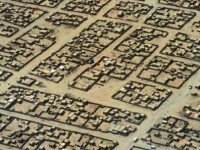Topics:
Urban Upgrading
Sustainable Housing
Rapid Urbanization
Location: Khartoum, Sudan
Year: 1991
 Background:
Khartoum is historically the main destination of migration in Sudan. It hosts 45 per cent of total rural-urban migration and 50 per cent of the Internally Displaced Persons (IDPs). Khartoum hosted 79 per cent of all migrants between 1983 and 1993 and about 83 per cent between 1993 and 2008. IDPs were accommodated in the four huge camps of Wad Elbashir, Mayo, Dar Alsalam and Jabal Awlya. The combined population of these camps reached 1,284,340 in 1995, with 76 per cent from South Sudan. After the Comprehensive Peace Agreement in 2005, which established peace in Sudan and provided for the creation of South Sudan, half of Khartoum’s IDPs returned to South Sudan (UNEP 2007).
Background:
Khartoum is historically the main destination of migration in Sudan. It hosts 45 per cent of total rural-urban migration and 50 per cent of the Internally Displaced Persons (IDPs). Khartoum hosted 79 per cent of all migrants between 1983 and 1993 and about 83 per cent between 1993 and 2008. IDPs were accommodated in the four huge camps of Wad Elbashir, Mayo, Dar Alsalam and Jabal Awlya. The combined population of these camps reached 1,284,340 in 1995, with 76 per cent from South Sudan. After the Comprehensive Peace Agreement in 2005, which established peace in Sudan and provided for the creation of South Sudan, half of Khartoum’s IDPs returned to South Sudan (UNEP 2007).
There is a long history of spatial planning regulation in Sudan, dating back to 1912; current planning is currently based on a new structure plan of Khartoum State 2007- 2033. Government responses towards dire urban issues like migration, squatters and illegality, however, are trailing behind and not addressing problem when they arose. The National Quarter Strategy (2007-2031) too does not give guidance on these important urban issues. In 1993, the highly primate city of Khartoum had 9.5 times the population of the country’s second-largest city of Port Sudan. In 2008 it is 8.7 times the now second-largest city of Nyala (Darfur). Illegal and squatter housing proliferated, reaching its apex in 1989 when these constituted 60 per cent of the Khartoum city population in about 96 separate settlements.
Four major attempts between 1960 and 1989 to address these problems all failed because of erroneous approaches: The forced slum eradication practices of the 1970s and 1980s merely led to squatters changing their location around the city. Land price controls levying high taxes for land exchange only brought higher land prices and land speculations. Rent control acts in favour of low-income households discouraged developers and increased demand, prices and speculations. The creation of a huge green belt around the city to stop the proliferation of peri-urban squatting, failed because the squatters simply leap-frogged across the belt in new settlements.
Project: The Dar Alsalam concept was introduced in 1991 to address the problems of the huge squatting and IDP communities. It adopted a site and services approach, providing 200m2 plots with title deeds and communal basic services against 10 per cent of the market price. Building by-laws were suspended in these areas to allow for low-cost construction and share facilities. It commenced with a replicable module of 10,000 plots in three areas at the fringe of the city. The new approach has shown positive results and has a relatively short consolidation time of around ten years.
Results: The Dar Alsalam project was replicated around the seven localities of Khartoum State and 273,711 squatter and IDP households had been resettled in 2005 (UN-Habitat 2009). Through this new approach, squatter housing in Khartoum fell from 60 per cent in 1989 to a mere 17 per cent in 2008. It secured tenure for the urban poor and IDPs but, on the other hand, this process prompted further migration to Khartoum and contributed to the sheer unlimited horizontal expansion of the city. Khartoum, with a 2008 census population of 5.27 million is now 45 times larger than in 1956.
Transferability: This good practice appears in the State of the Arab Cities, a UN-Habitat publication that I2UD took the lead authoring. In this report, Sudan is categorized as a member of the Southern Tier, a group consisting of the least developed economies in the Arab League, including Yemen, Mauritania, Comoros, Djibouti, and Somalia. All these countries must contend with high poverty and urbanization rates. Oftentimes, the drivers of poverty also encourage urbanization. For instance, environmental stressors such as drought and persistent conflict devastate rural economies; environmental and conflict refugees seek new opportunities and safety in cities. Sana’a in Yemen, Djiboutiville in Djibouti, Mogadishu in Somalia, and Khartoum are all the primary receptors of these type of migrants – they also standout as disproportionately larger than their country’s second cities. Crisis-driven urbanization often overwhelms city infrastructure. The Dar Alsalam is but one example of the steps local governments take to ameliorate the resulting low quality housing.
Sources: As cited in the State of the Arab Cities.UNEP. “Sudan: Post-Conflict Environmental Assessment.” Nairobi: United Nations Environmental Program, 2007. http://postconflict.unep.ch/publications/UNEP_Sudan.pdf
UN Human Settlements Programme. “Urban Sector Studies and Capacity Building for Khartoum State.” UN-Habitat. 2009.
Photos courtesy of: ©Bruno Gilissen/iStockPhoto (top), UNEP 2007 (middle)

